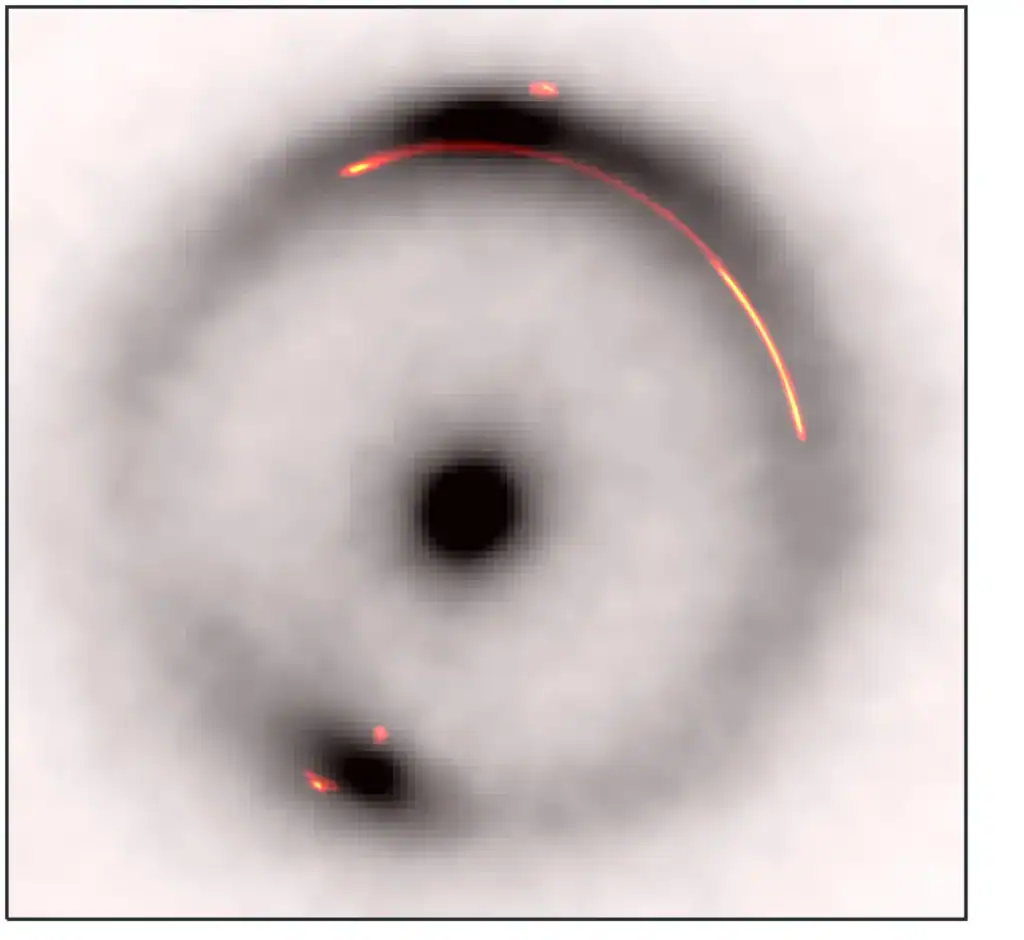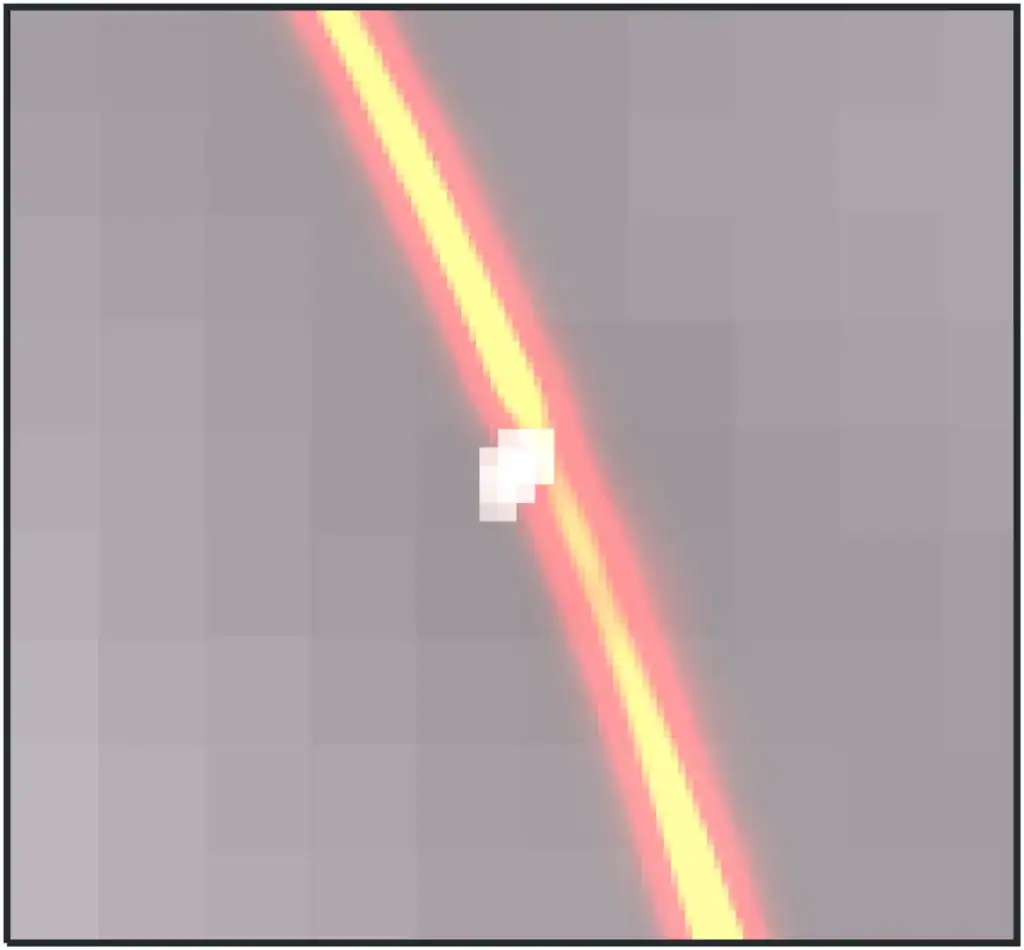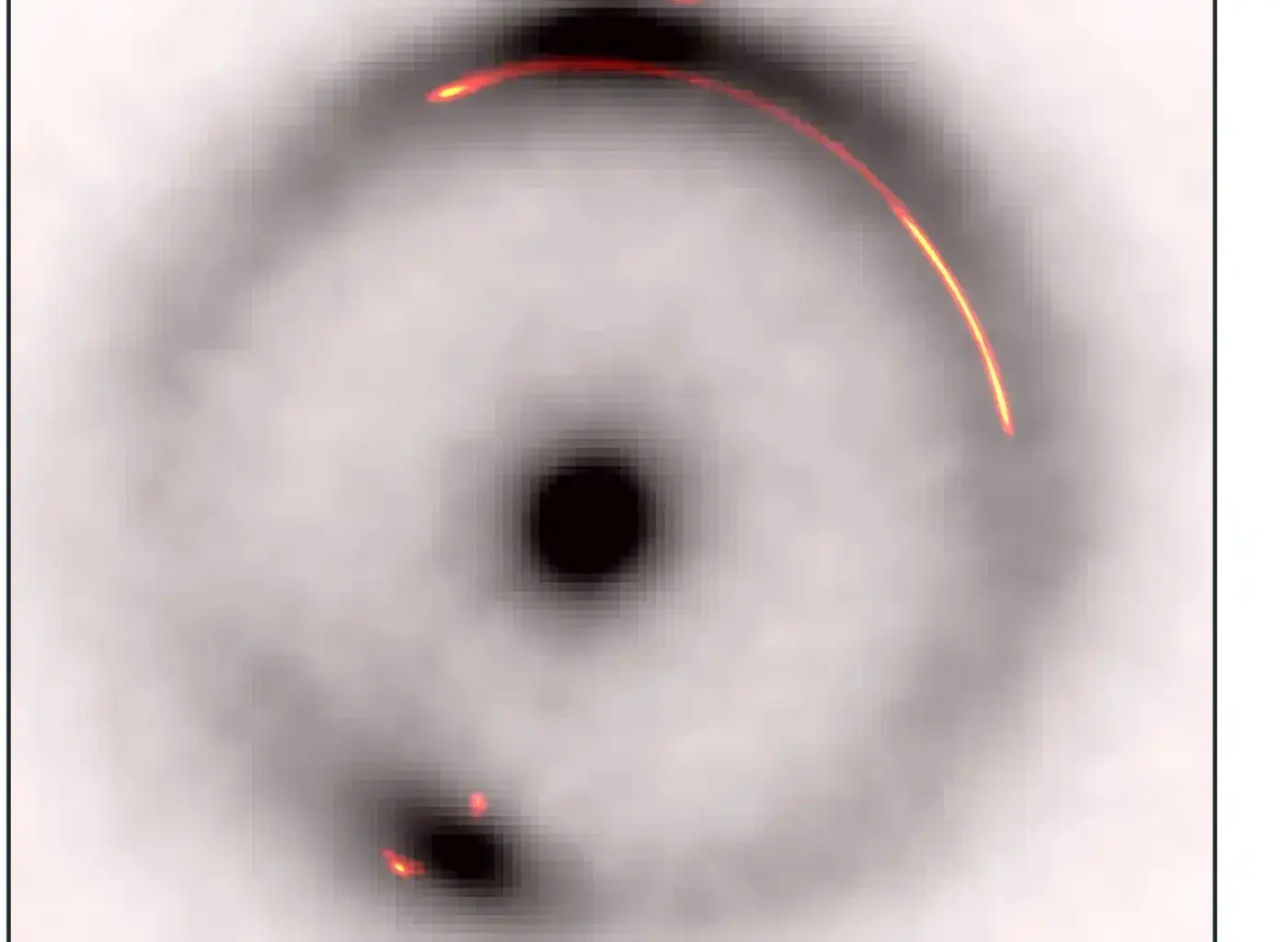 Overlay of the infrared emission (black and white) with the radio emission (colored). The dark, low-mass object is located at the gap in the bright part of the arc on the right hand side. Credit : Keck/EVN/GBT/VLBA
Overlay of the infrared emission (black and white) with the radio emission (colored). The dark, low-mass object is located at the gap in the bright part of the arc on the right hand side. Credit : Keck/EVN/GBT/VLBA
For decades, astronomers have searched for something they cannot see. They call it dark matter—an invisible substance thought to make up most of the universe’s mass, sculpting galaxies and clusters with its gravity. Now, researchers say they have spotted the smallest dark matter clump ever detected, a million times more massive than the Sun yet entirely dark.
The discovery, described in Nature Astronomy by Devon Powell of the Max Planck Institute for Astrophysics and colleagues, came almost by accident. The team was observing an extraordinary Einstein ring, an almost perfect circle of light created when a massive foreground galaxy warps the light of a distant one behind it. “Hunting for dark objects that do not seem to emit any light is clearly challenging,” Powell said in a statement.
What they found was a tiny notch in that luminous ring.
Dark Distortion in the Arc
The team was studying a radio source known as JVAS B1938+666, located roughly 10 billion light-years away. A supermassive black hole powers this young radio galaxy, which is known as a compact symmetric object, or CSO. As another paper in Monthly Notices of the Royal Astronomical Society details, its light forms an extremely thin gravitational arc, one of the sharpest ever observed.
But as the astronomers mapped the arc in exquisite detail, combining radio telescopes across the planet, they noticed something strange. Part of the arc seemed distorted, as if someone had pinched the light itself.
To see what caused that disturbance, Powell’s team used a powerful computational technique called gravitational imaging. In essence, they built a map of the gravity shaping the arc, pixel by pixel, on supercomputers. When they compared their models with and without the mysterious object, one version fit the data far better.
Without the extra mass, the simulated ring showed an obvious flaw: a discontinuity in the light. With it, the arc smoothed out perfectly. “It’s an impressive achievement to detect such a low mass object at such a large distance from us,” said Chris Fassnacht, a co-author from the University of California, Davis. The object’s mass: about 1.13 million Suns, contained within a region only 80 parsecs wide.
The Invisible Clump
 The pinch. Credit: Keck/EVN/GBT/VLBA
The pinch. Credit: Keck/EVN/GBT/VLBA
Nothing about the newfound object emits light—not in radio, optical, or infrared wavelengths. That leaves two possibilities. It could be an ultracompact, inactive dwarf galaxy or it could be something even more intriguing: a pure clump of dark matter, the smallest yet seen by a factor of 100.
“Given the sensitivity of our data, we were expecting to find at least one dark object,” said Powell. “So our discovery is consistent with the so-called cold dark matter theory on which much of our understanding of how galaxies form is based.”
That theory, known as ΛCDM (Lambda Cold Dark Matter), has guided cosmology for decades. It posits that the universe is dominated by a cosmological constant (Λ) and by “cold” dark matter—slow-moving, invisible particles that cluster together under gravity. If those particles were “hot,” moving near the speed of light, they would smear out small structures, preventing tiny clumps like this one from forming. The mere existence of this object, then, supports the idea that dark matter can indeed bunch up on smaller scales.
What Could It Be?
If this truly is a dark matter clump, it fits neatly within expectations of cold dark matter models. In fact, simulations suggest that galaxies like the Milky Way should be riddled with such subhaloes—millions of invisible clumps orbiting within their halos. Yet astronomers had never seen one at this small scale until now.
Interestingly, the team notes that the clump’s density may be higher than typical predictions from dark matter simulations. That’s reinforced by similar findings for other small perturbers discovered through lensing, raising questions about whether these halos are more compact than theory suggests.
For now, Powell and his colleagues are cautious. The nature of the object remains uncertain until astronomers can look deeper for any trace of starlight or other emissions. “A more definitive statement on what type of object it is will require deep optical or infrared observations,” the team writes. That will be a challenge, given the brilliant glare of the lensed galaxy behind it.
The discovery marks the first time an object this small and this far away has been found using only its gravitational pull. It opens a new way to study the universe—by mapping the unseen structure that holds it in place.
“This is the lowest-mass object known to us, by two orders of magnitude, to be detected at a cosmological distance by its gravitational effect,” the authors wrote. “Finding low-mass objects such as this one is critical for learning about the nature of dark matter,” added Fassnacht, as per Cosmos Magazine.
As telescopes grow even more sensitive, astronomers hope to spot dozens—or hundreds—more such “pinches” in the fabric of light. Each one could help answer the universe’s most elusive question: what exactly is the dark matter that binds it all?

